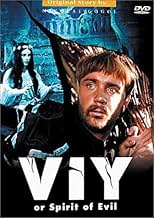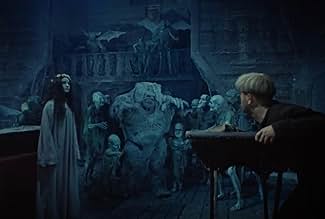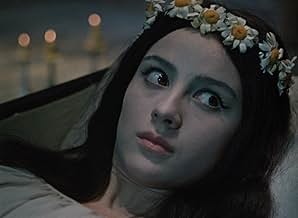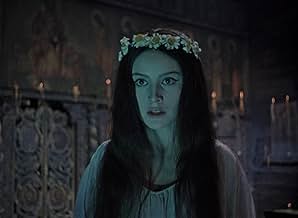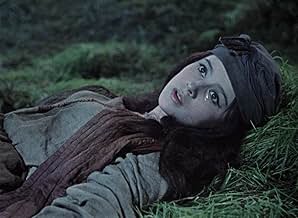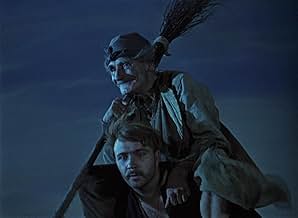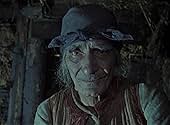Viy
- 1967
- Tous publics
- 1h 17m
IMDb RATING
7.2/10
11K
YOUR RATING
A young priest is ordered to preside over the wake of witch in a small old wooden church of a remote village. This means spending three nights alone with the corpse with only his faith to pr... Read allA young priest is ordered to preside over the wake of witch in a small old wooden church of a remote village. This means spending three nights alone with the corpse with only his faith to protect him.A young priest is ordered to preside over the wake of witch in a small old wooden church of a remote village. This means spending three nights alone with the corpse with only his faith to protect him.
Natalya Varley
- Pannochka
- (as N. Varley)
Aleksey Glazyrin
- Sotnik
- (as A. Glazyrin)
Nikolay Kutuzov
- Witch
- (as N. Kutuzov)
Vadim Zakharchenko
- Khalyava
- (as V. Zakharchenko)
Pyotr Vesklyarov
- Prncipal of the Seminary
- (as P. Vesklyarov)
- …
Vladimir Salnikov
- Gorobets
- (as V. Salnikov)
Dmitriy Kapka
- Overko
- (as D. Kapka)
Stepan Shkurat
- Yavtukh
- (as S. Shkurat)
Georgiy Sochevko
- Stepan
- (as G. Sochevko)
Nikolay Yakovchenko
- Spirid
- (as N. Yakovchenko)
Nikolay Panasev
- Comforter
- (as N. Panasev)
Boryslav Brondukov
- Seminarian
- (uncredited)
Aleksandra Denisova
- Peasant
- (uncredited)
Lyubov Kalyuzhnaya
- Peasant
- (uncredited)
Viktor Kolpakov
- Peasant
- (uncredited)
Mikhail Kramar
- Seminarian
- (uncredited)
Margarita Krinitsyna
- Gafiyka
- (uncredited)
Featured reviews
I'm not particularly a fan of horror flicks. I watched this movie simply because I wanted to see something Russian. But as I found out, this is much more than a typical horror flick. It has a lyrical quality to it almost like a Greek play. True, it has ghosts & goblins & creepy things in it. But so do Greek plays.
I consider this to be a fantasy or an allegory with some nice subtle insights about rustic life and the human condition in general. Some of the witty dialogue is absolutely priceless. I'm not familiar with the writings of Gogol who wrote the original story of "Viy", but if you're a fan of Tolstoy's short stories ("The Imp and the Crust") or Guy de Maupassant ("The Devil") or maybe the lighter side of Poe ("Never Bet the Devil Your Head"), then this'll be right up your alley.
And of course it'll scare the socks off your arse.
The camera illusions in this movie are absolutely 1st class. Don't be put off by the fact that it had a "low budget" by Hollywood standards. The minimalist approach really brought out the director's creativity in this case. Like an old 1940s Jean Cocteau film, the special effects are timeless in their simplicity, and they will hold up for the next 50 years, long after CGI has gone the way of the dodo (and not a moment too soon).
I consider this to be a fantasy or an allegory with some nice subtle insights about rustic life and the human condition in general. Some of the witty dialogue is absolutely priceless. I'm not familiar with the writings of Gogol who wrote the original story of "Viy", but if you're a fan of Tolstoy's short stories ("The Imp and the Crust") or Guy de Maupassant ("The Devil") or maybe the lighter side of Poe ("Never Bet the Devil Your Head"), then this'll be right up your alley.
And of course it'll scare the socks off your arse.
The camera illusions in this movie are absolutely 1st class. Don't be put off by the fact that it had a "low budget" by Hollywood standards. The minimalist approach really brought out the director's creativity in this case. Like an old 1940s Jean Cocteau film, the special effects are timeless in their simplicity, and they will hold up for the next 50 years, long after CGI has gone the way of the dodo (and not a moment too soon).
Although the film starts off a bit in the fairy tale fashion, the film doesn't lack anything a great sixties horror movie, be it from Italy, England or the U.S. should have. I think it's wonderful that a Russian gem like this got re-released in the US, so that I could see it in Germany. If this movie had been distributed better, I think it would turn up in every horror movie history besides the works of Bava (yes, MASCHERA DEL DEMONIO was based on the same story...although the Russian version sticks a lot more to Gogol) and the Hammer and Roger Corman Productions. If you're a fan of atmospheric sixties horror, you definitely should see this one, if only for the unforgettable climax.
"Vij" is a masterpiece of Russian cinema and a masterpiece of 60s horror. Having said that, it is perhaps a film that may not appeal to the gorehound variety of horror fan. Not only does it not possess any gore, but it plays for much of its length like a bucolic Russian fairy tale. The scary scenes when they come are in the last 20 minutes or so.
What makes "Vij" so wonderful are the lovingly shot scenes of rural Russia. The faces of all the peasants are shown in frequent close-up: ruddy, jovial, deeply lined with characterful wrinkles, blue-gray eyes twinkling. The camera is used to great effect in close-ups, blurry shots, spinning around our hero, zooming in and out, and those loving shots of farm houses and livestock. It often has a dream-like character and certain supernatural scenes are extremely surreal and effective. The blend of lighthearted comedy and echoes of folklore and a near-religiosity at times is also extremely effective. The lead does an excellent job as Khoma and his cohort of minders are equally good. Our deceased witch is a picture of beauty and reminds one of Snow White, such is her rosy-cheeked, fairytale beauty.
I could go on and on about what makes this film so wonderful. I'll suffice to comment on one more feature. The music by Karen Khatchaturian (nephew of the great Aram Khatchaturian, he of the "Sabre Dance" and the "Onedin Line" theme music) is very effective and draws on the sounds of several other Russian greats. One reviewer here mentioned both Prokofiev and Rachmaninov. I thought the exact same thing in the same scenes. There is an overall Prokofevian sound to the music and the choral numbers bring to mind Rachmaninov's "All-Night Vigil", most likely intentionally. The music in the demon scenes draws on Mussorgsky's "Nite on Bald Mountain" with its eerie string scratchings, again most likely intentionally. These are wonderful and evocative sources for Khatchaturian to draw from.
In summation, this is a cinematic masterpiece and is a must for fans of Russian cinema or classic cinema in general. Horror fans who can enjoy say, "Nosferatu", "The Cabinet of Dr Caligari", "Black Sunday", "Carnival of Souls" or other early greats, will no doubt want to seek this out. "Vij" is one of the early greats of the genre which it also transcends.
What makes "Vij" so wonderful are the lovingly shot scenes of rural Russia. The faces of all the peasants are shown in frequent close-up: ruddy, jovial, deeply lined with characterful wrinkles, blue-gray eyes twinkling. The camera is used to great effect in close-ups, blurry shots, spinning around our hero, zooming in and out, and those loving shots of farm houses and livestock. It often has a dream-like character and certain supernatural scenes are extremely surreal and effective. The blend of lighthearted comedy and echoes of folklore and a near-religiosity at times is also extremely effective. The lead does an excellent job as Khoma and his cohort of minders are equally good. Our deceased witch is a picture of beauty and reminds one of Snow White, such is her rosy-cheeked, fairytale beauty.
I could go on and on about what makes this film so wonderful. I'll suffice to comment on one more feature. The music by Karen Khatchaturian (nephew of the great Aram Khatchaturian, he of the "Sabre Dance" and the "Onedin Line" theme music) is very effective and draws on the sounds of several other Russian greats. One reviewer here mentioned both Prokofiev and Rachmaninov. I thought the exact same thing in the same scenes. There is an overall Prokofevian sound to the music and the choral numbers bring to mind Rachmaninov's "All-Night Vigil", most likely intentionally. The music in the demon scenes draws on Mussorgsky's "Nite on Bald Mountain" with its eerie string scratchings, again most likely intentionally. These are wonderful and evocative sources for Khatchaturian to draw from.
In summation, this is a cinematic masterpiece and is a must for fans of Russian cinema or classic cinema in general. Horror fans who can enjoy say, "Nosferatu", "The Cabinet of Dr Caligari", "Black Sunday", "Carnival of Souls" or other early greats, will no doubt want to seek this out. "Vij" is one of the early greats of the genre which it also transcends.
Since I missed the showings other posters have mentioned, it took awhile for me to catch up with this on DVD. Nine and a half out of ten; a really wonderful horror fantasy. I would add only that the young preists harrowing experience
might well have inspired the Western horror novel and film "The Exorsist." I like this one, however, much better. This film is funny, scary, and visualy impressive. A real gem.
might well have inspired the Western horror novel and film "The Exorsist." I like this one, however, much better. This film is funny, scary, and visualy impressive. A real gem.
This was one of several fantasy films released by the DVD label RusCiCo (Russian Cinema Council) to promote classics in the field which would seldom have traveled outside their native land; it remains the only one I have watched (though I own quite a few) and, for the record, my second acquaintance with it came via a copy off "You Tube" rather than the extras-laden disc itself as a complementary viewing to Mario Bava's BLACK Sunday (1960) – since both films were inspired by the Nikolai Gogol tale "The Vij".
Needless to say, this version is much closer to the source material but this does not make it the better rendition; truth be told, many horror classics have been loosely adapted to the screen and, yet, the end result has been wholly embraced by critics and fans alike (say, James Whale's FRANKENSTEIN {1931}, Terence Fisher's Dracula {1958}, or any of Roger Corman's efforts inspired by the work of Edgar Allan Poe). Bava's film rightly placed the witch at the center of the narrative (amazingly, almost without her ever emerging from the family crypt!) whereas this film – and, one assumes, the original text – makes the frankly boring seminarian hero its protagonist. At just 72 minutes, the movie certainly does not overstay its welcome – but it also somewhat exposes the essentially thin plot line: a young man is helped by an old lady, but he understandably snubs her unwarranted advances; however, he allows her to ride him piggyback(!) only for them to slowly rise off the ground, revealing her to be a witch. Back on firm land, the aspiring cleric beats up the woman, who turns to her true form of a young girl – after which the boy flees the scene. As soon as he reports back to the seminary, he is told to travel to the estate of a prominent local family to pray over the body of their dying daughter; when he arrives, it transpires not only that the afflicted party is the witch herself (who expressly asked for him to be there!) but that she had succumbed to her wounds. Tradition now binds him to make a 3-night vigil over her corpse but her plan is to exact revenge by tormenting him with assorted supernatural occurrences that, inevitably, lead to his own demise (which proves just-as-baffling to outsiders, especially as he seems to be getting old before his time)!
The film looks very handsome in colour, and the striking special effects work by "artistic director" Aleksandr Ptushko are at once charming and sinister; still, these are mainly relegated to the final night – as the first two go by a bit too quickly, serving only for the revivified girl to repeatedly attempt in breaking the chalk-drawn circle inside which the young man has managed to attain sanctuary (once using the coffin itself as a battering ram!). The parade of grotesques at the end include the briefly-seen titular creature, which is not averse to being used as comedy relief – since the Vij asks its acolytes to fold out its overgrown ears because they are obstructing its field of vision i.e. their intended prey! Unsurprisingly, the movie is Russian to the bone – so that we get much carousing (singing, drinking and camaraderie) throughout – which tends to deflect attention from the otherwise nicely- handled genre trappings and brings me back to the notion that, sometimes, foreign-made versions of any given tale can have a better chance of externalizing its core themes.
Needless to say, this version is much closer to the source material but this does not make it the better rendition; truth be told, many horror classics have been loosely adapted to the screen and, yet, the end result has been wholly embraced by critics and fans alike (say, James Whale's FRANKENSTEIN {1931}, Terence Fisher's Dracula {1958}, or any of Roger Corman's efforts inspired by the work of Edgar Allan Poe). Bava's film rightly placed the witch at the center of the narrative (amazingly, almost without her ever emerging from the family crypt!) whereas this film – and, one assumes, the original text – makes the frankly boring seminarian hero its protagonist. At just 72 minutes, the movie certainly does not overstay its welcome – but it also somewhat exposes the essentially thin plot line: a young man is helped by an old lady, but he understandably snubs her unwarranted advances; however, he allows her to ride him piggyback(!) only for them to slowly rise off the ground, revealing her to be a witch. Back on firm land, the aspiring cleric beats up the woman, who turns to her true form of a young girl – after which the boy flees the scene. As soon as he reports back to the seminary, he is told to travel to the estate of a prominent local family to pray over the body of their dying daughter; when he arrives, it transpires not only that the afflicted party is the witch herself (who expressly asked for him to be there!) but that she had succumbed to her wounds. Tradition now binds him to make a 3-night vigil over her corpse but her plan is to exact revenge by tormenting him with assorted supernatural occurrences that, inevitably, lead to his own demise (which proves just-as-baffling to outsiders, especially as he seems to be getting old before his time)!
The film looks very handsome in colour, and the striking special effects work by "artistic director" Aleksandr Ptushko are at once charming and sinister; still, these are mainly relegated to the final night – as the first two go by a bit too quickly, serving only for the revivified girl to repeatedly attempt in breaking the chalk-drawn circle inside which the young man has managed to attain sanctuary (once using the coffin itself as a battering ram!). The parade of grotesques at the end include the briefly-seen titular creature, which is not averse to being used as comedy relief – since the Vij asks its acolytes to fold out its overgrown ears because they are obstructing its field of vision i.e. their intended prey! Unsurprisingly, the movie is Russian to the bone – so that we get much carousing (singing, drinking and camaraderie) throughout – which tends to deflect attention from the otherwise nicely- handled genre trappings and brings me back to the notion that, sometimes, foreign-made versions of any given tale can have a better chance of externalizing its core themes.
Did you know
- TriviaNikolay Stepanov who plays the demon Viy, was a circus artist. He was cast for his strength, because costume of the creature was extremely heavy.
- GoofsWhile stopping at the inn for food and vodka (on the way to Sotnik's village) the horses are taken off the carriage, fed and watered too, but in between the shots of the horses, firstly, being watered and then fed, we still see them attached to the carriage between shots.
- ConnectionsFeatured in Woodlands Dark and Days Bewitched: A History of Folk Horror (2021)
- SoundtracksNight on Bald Mountain
Composed by Modest Mussorgsky
- How long is Viy?Powered by Alexa
Details
Contribute to this page
Suggest an edit or add missing content


